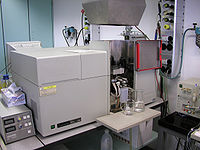Atomic absorption spectroscopy

Okay kiddo, let me explain to you what atomic absorption spectroscopy means.
You know how things are made up of tiny building blocks called atoms, right? Atoms are really small, even smaller than the tiniest speck of dust you can see. But just because we can’t see them, doesn’t mean they aren’t important.
Scientists use a special tool called a spectrometer to study atoms. It’s like a glasses for atoms! One type of spectrometer is called an atomic absorption spectrometer.
An atomic absorption spectrometer helps scientists see what’s inside different things, like water or other liquids. They do this by first burning or heating the liquid up so its atoms get super excited and start jumping around. Then, the spectrometer shines a light on the liquid and looks at how much of the light is absorbed by the atoms in the liquid.
Different types of atoms will absorb different amounts and types of light, sort of like how you might look different in a green shirt versus a red shirt. This information can tell scientists what types of atoms are in the liquid.
So, let’s say we want to know how much iron is in the water we drink. We can use an atomic absorption spectrometer to test it. By seeing how much light is absorbed by the iron atoms in the water, we can figure out how much iron is in there.
Pretty cool, right? Atomic absorption spectroscopy helps us understand what’s in the world around us!
You know how things are made up of tiny building blocks called atoms, right? Atoms are really small, even smaller than the tiniest speck of dust you can see. But just because we can’t see them, doesn’t mean they aren’t important.
Scientists use a special tool called a spectrometer to study atoms. It’s like a glasses for atoms! One type of spectrometer is called an atomic absorption spectrometer.
An atomic absorption spectrometer helps scientists see what’s inside different things, like water or other liquids. They do this by first burning or heating the liquid up so its atoms get super excited and start jumping around. Then, the spectrometer shines a light on the liquid and looks at how much of the light is absorbed by the atoms in the liquid.
Different types of atoms will absorb different amounts and types of light, sort of like how you might look different in a green shirt versus a red shirt. This information can tell scientists what types of atoms are in the liquid.
So, let’s say we want to know how much iron is in the water we drink. We can use an atomic absorption spectrometer to test it. By seeing how much light is absorbed by the iron atoms in the water, we can figure out how much iron is in there.
Pretty cool, right? Atomic absorption spectroscopy helps us understand what’s in the world around us!
Related topics others have asked about:
